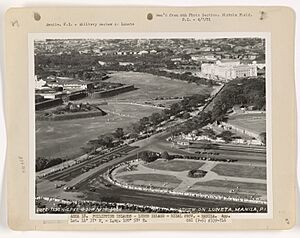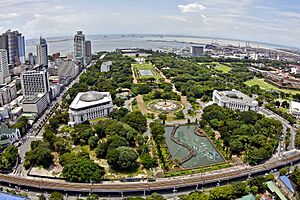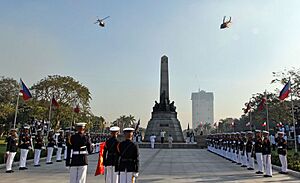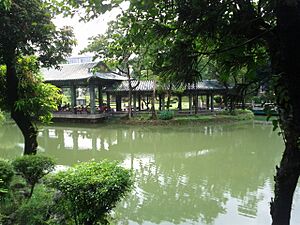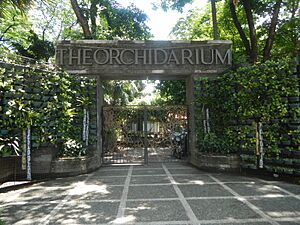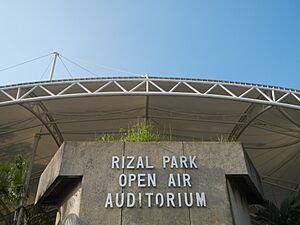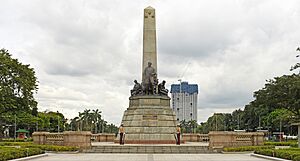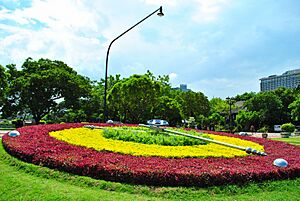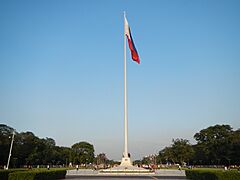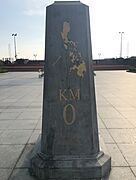Rizal Park facts for kids
Quick facts for kids Rizal Park |
|
|---|---|
| Liwasang Rizal (Filipino) | |

The Rizal Monument in Rizal Park
|
|
| Type | Urban park |
| Location | Ermita, Manila |
| Area | 58 hectares (140 acres) |
| Created | 1820 |
| Administered by | National Parks Development Committee |
| Plants | 3,497 trees (2015) |
| Species | 112 tree species (2015) |
| Public transit access | |
Rizal Park (also known as Luneta Park or just Luneta) is a famous and historic park in Ermita, Manila, Philippines. It's one of the biggest parks in the country, covering about 58 hectares (that's like 143 football fields!). This park is super important to the history of the Philippines.
Long ago, this area was called Bagumbayan during the time Spain ruled the Philippines. It's right next to the old walled city of Intramuros. A very important event happened here on December 30, 1896: the execution of a Filipino hero named José Rizal. This event helped start the 1896 Philippine Revolution against Spain. The park was later named after him, and his monument is a main feature.
The Philippines also declared its independence from the United States here on July 4, 1946. Many big political gatherings have happened in Rizal Park, including those that led to the People Power Revolution in 1986.
Contents
History of Rizal Park
Spanish Rule and Early Days
Rizal Park started as the "Paseo de Luneta" in 1820. It was built on marshy land near the beach, just south of Manila's walls. Before the park, there was a small town called Bagumbayan here since 1601. This town was cleared out after the British briefly took over Manila from 1762 to 1764.
The area then became known as Bagumbayan Field. It had military buildings and a crescent-shaped part of the city's defenses called a lunette. The "Paseo de la Luneta" was a popular place for people in Manila to gather in the evenings. It had paths, lawns, and a wide road for carriages.
During Spanish rule, especially from 1823 to 1897, this area was used for public executions. Many people who opposed Spain were executed here. On February 17, 1872, three Filipino priests, Mariano Gomez, José Burgos, and Jacinto Zamora (known as Gomburza), were executed. They were accused of rebellion after the 1872 Cavite mutiny.
American Period and Rizal Monument
When the Americans ruled the Philippines, the famous Rizal Monument was built. On September 28, 1901, a law was passed to create a monument in Luneta to honor José Rizal. He was a Filipino patriot, writer, and poet. The monument was officially opened on December 30, 1913, which was 17 years after Rizal's death.
An architect named Daniel Burnham also planned for government buildings to be built in the park. He imagined grand buildings with Greek-Roman columns, like a Philippine version of the United States Capitol. Only two of these buildings were finished before World War II. They are now the National Museum of Anthropology and the National Museum of Natural History.
After Philippine Independence
In 1954, President Ramon Magsaysay created a commission to celebrate 100 years since José Rizal's birth. They planned to build a big monument and a cultural center. On December 19, 1955, the area around the Rizal Monument was declared a national park.
In 1963, the National Parks Development Committee (NPDC) was created to manage the park. In 1967, President Ferdinand Marcos officially renamed Luneta National Park to Rizal Park. During his time, the Chinese and Japanese Gardens were also added. The park also started hosting the "Concert at the Park" events.
On June 12, 1998, Rizal Park was the main place for the Philippine Centennial celebrations. This event marked 100 years since the Philippines declared independence from Spain. Over five million people celebrated in the park!
Recent History
Rizal Park was renovated in 2011. The old musical dancing fountain was restored, along with the Flower Clock and the Noli Me Tangere Garden. These were opened just in time for Jose Rizal's 150th birthday celebration.
During the COVID-19 pandemic in March 2020, Rizal Park was temporarily closed. This time was used to make improvements to the park. A temporary hospital, the Manila COVID-19 Field Hospital, was also built in the park's Burnham Green.
Important Events at Rizal Park

Rizal Park has been the site of many important gatherings and celebrations:
- February 18, 1981 – The first beatification ceremony (a step towards sainthood) held outside the Vatican took place here. It was for Saint Lorenzo Ruiz and his companions, led by Pope John Paul II.
- February 16, 1986 – Many protests against the rule of Ferdinand Marcos happened here. These events eventually led to the People Power Revolution.
- January 15, 1995 – The final Mass of the 10th World Youth Day 1995 was held here. Over 4 million people attended, making it the largest gathering in the history of the Roman Catholic Church.
- June 12, 1998 – The Philippine Centennial Celebrations marked 100 years since the Philippines declared independence. A huge parade and fireworks display took place, with over five million people celebrating.
- November 27, 2005 – Rizal Park hosted the opening ceremony for the 2005 Southeast Asian Games. It was the first time a Southeast Asian Games opening ceremony was held in an open-air park instead of a stadium.
- August 22–26, 2013 – The Million People March was held here. People protested against the misuse of government funds.
- January 18, 2015 – The final Mass of Pope Francis' visit was held here. More than 6 million people attended, making it the largest papal gathering ever.
- March 16, 2024 – The park achieved a Guinness World Record for the largest human lung formation. 5,596 people participated to mark World Tuberculosis Day.
- January 13, 2025 – The National Rally for Peace led by the Iglesia ni Cristo was held here, with 1.5 million people attending.
Regular Events
- A Flag-Raising Ceremony is held every first Monday of the month at the Independence Flagpole.
- The annual celebration of the Traslacion (January 9) starts at the Quirino Grandstand in the park. Millions of devotees attend this event.
- The park hosts annual celebrations for Independence Day (June 12), Rizal Day (December 30), and New Year's Eve (December 31).
- It's also a common starting or ending point for national running events like the Milo Marathon.
- New Presidents of the Philippines often take their oath of office and give their first speech at the park.
Park Layout and Features

Rizal Park is divided into three main parts:
- Northeastern Section: This part is about 16 hectares and is home to the National Museum Complex. Here you'll find the Agrifina Circle, the National Museum of Natural History, and the National Museum of Anthropology.
- Central Section: This 22-hectare area is the main part of the park. It includes the Rizal Monument, the Open-Air Auditorium, the Independence Flagpole, and the Central Musical and Dancing Fountain.
- Southwestern Section: This area has the Burnham Green, a 10-hectare open field, the Quirino Grandstand, and the Manila Ocean Park near Manila Bay.
| N W 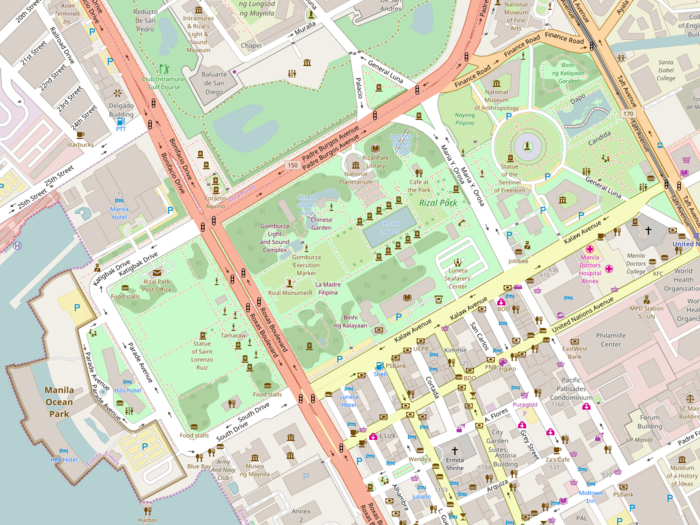 E ES |
||||
| Northeastern side | ||||
| Northwestern side | Southeastern side | |||
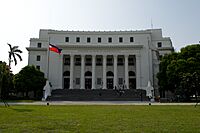 National Museum of Anthropology |
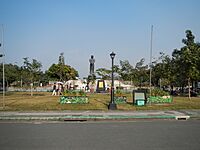 Agrifina Circle and the Sentinel of Freedom |
 National Museum of Natural History |
||
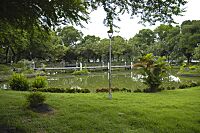 Japanese Garden |
 Rizal Monument |
 National Library of the Philippines |
||
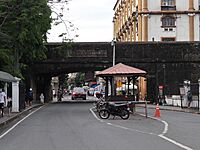 Intramuros |
 National Historical Commission of the Philippines |
|||
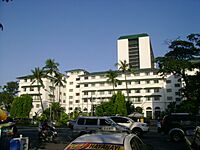 Manila Hotel |
 Quirino Grandstand |
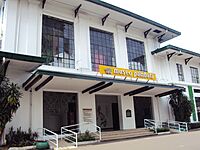 Museo Pambata, formerly the Manila Elks Club |
||
| Southwestern side | ||||
Gardens to Explore
- Children's Playground: A fun area for kids, located in the park's southeastern corner. It was renovated in 2011.
- Chinese Garden: Step through an ornate gate with dragons into this garden that looks like it came from old China. It has pagodas, gazebos, and a lagoon.
- Japanese Garden: These gardens were built to celebrate friendship between Japan and the Philippines. It's a nice place for walks around a Japanese-style garden, lagoon, and bridge.
- Noli Me Tangere Garden: This garden features the Heidelberg fountain, where Rizal used to drink water when he lived in Germany. It symbolizes Filipino-German friendship.
- Orchidarium and Butterfly Pavilion: Opened in 1994, this used to be a parking lot! Now it's a one-hectare rainforest-like park. It shows off many Philippine orchid species and butterflies.
Places for Events
- Open-Air Auditorium: Designed by famous architect Leandro Locsin, this stage offers free performances for everyone. You can watch dance, theater, and music shows by local and international artists. It also hosts "Cinema in the Open-Air" with free movie screenings.
- Quirino Grandstand: This grandstand was designed for the proclamation of Philippine Independence in 1946. It's where newly elected Philippine Presidents traditionally take their oath of office. Many important events have been held here.
- Parade Grounds and the Burnham Green: These large open spaces are perfect for fun runs, parades, and big gatherings. The Burnham Green is named after American architect Daniel Burnham. It's also a popular spot for picnics and sports.
- Valor's Hall/Bulwagan ng Kagitingan: This beautiful area is often chosen for events and cocktail parties because of its artistic design.
Educational Spots
- National Planetarium
- National Museum of Natural History
- National Museum of Anthropology: Located in a building north of Agrifina Circle, this museum holds collections about Philippine Anthropology and Archeology.
- National Library of the Philippines: This is the country's main public library. It has a rich collection of Filipino books and materials, helping students and researchers.
- National Museum of Fine Arts: Found at the northeastern tip of Rizal Park, this museum displays amazing Filipino art.
- Manila Ocean Park: An oceanarium located at the westernmost part of Luneta, behind the Quirino Grandstand. It opened on March 1, 2008.
Artworks and Monuments
Rizal Monument
The bronze and granite Rizal Monument is one of the most famous landmarks in the Philippines. Important visitors often lay wreaths here. The monument not only features a statue of Rizal but also holds his remains.
A law was passed on September 28, 1901, to build this monument. An international design competition was held, and a Swiss sculptor named Richard Kissling won with his design, "Motto Stella" (Guiding Star). The monument was finally unveiled on December 30, 1913, on Rizal's 17th death anniversary. His famous poem, Mi último adiós ("My Last Farewell"), is written on the memorial plaque. Soldiers from the Philippine Marine Corps guard the site.
Other Art and Memorials
- Artist's Haven/Kanlungan ng Sining: This area showcases artistic and natural artworks. It has a gallery run by the Arts Association of the Philippines.
- Artworks in the Park: Rizal Park displays various artworks by famous Filipino artists:
- Dancing Rings: A copy of Joe Datuin's sculpture, which won a big prize in an international sports and arts contest.
- The New Filipino/Ang Bagong Pinoy: Another sculpture by Joe Datuin, showing intertwined rings that look like a person, representing a new Filipino.
- Ang Pagbabago (The Change) Mosaic Murals: These murals represent Filipino hopes for peace, love, unity, and a better future.
- Execution place of Gomburza: An obelisk marks the spot where the three priest-martyrs, Gomburza, were executed.
- Diorama of Rizal's Martyrdom: North of the Rizal Monument, you'll find statues showing Rizal's execution. This is the actual spot where he was martyred. In the evenings, a light and sound show tells the story of his last moments.
- Filipino-Korean Soldier Monument: This monument shows two Filipino soldiers helping a Korean soldier. It honors Filipino soldiers who fought with Korean troops during the Korean War.
- Soul Waves: This artwork represents sea waves and honors Filipinos who died during World War II. Korea placed it in the park as a sign of respect.
- The Flower Clock: This clock is built into a flower bed. It has been a feature of the park since the 1960s and was restored in 2011.
- The Gallery of Heroes: This is a row of bust sculptures of important Philippine heroes.
- Statue of the Sentinel of Freedom (or the Lapu-Lapu Monument): This monument was a gift from the people of Korea. It thanks Filipinos who helped during the Korean War. It honors Lapu-Lapu, a native chieftain who was the first to resist Spanish colonization in the Philippines.
Other Cool Features
- Independence Flagpole: Standing at 105 feet (about 32 meters), this is the tallest flagpole in the Philippines. On July 4, 1946, the Philippines' full independence was declared right here. The flagpole was made even taller in 2013, reaching 150 feet (about 46 meters).
- Kilometer Zero: Located in the park on Roxas Boulevard, in front of the Rizal Monument. This is the starting point from which all road distances in Manila are measured.
- Musical Dancing Fountain: This is considered the biggest and most lively dancing fountain in the country. The central lagoon puts on a show with water shooting up to 88 feet (27 meters), fireballs, and water screens.
Trees and Plants
In 2015, an inventory showed that Rizal Park has 3,497 trees! These trees belong to 112 different species. A large number of them, 527 individual trees, are narra trees, which are native to the Philippines.
Safety in the Park
To make the park safer for everyone, 30 high-definition security cameras were installed in 2012. The National Parks Development Committee also has police and security officers stationed in important areas of the park.
Rizal Parks Around the World
Just like there are many Rizal Avenues, most towns and cities in the Philippines have a Rizal Park or a Plaza Rizal. These usually have a monument to José Rizal. There's also a Rizal Park in Seattle, USA. In 2019, a statue and monument of Jose Rizal were also put up in Luneta Park in Markham, Canada.
See also
 In Spanish: Parque Rizal para niños
In Spanish: Parque Rizal para niños
- Jose Rizal
- Rizal Monument
- Paco Park
External links
- National Parks Development Committee
- Photos from Flickr
- Photos of Luneta
cs:Luneta



